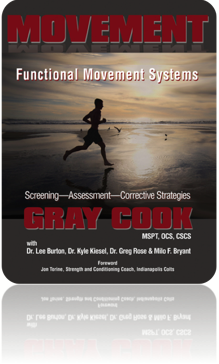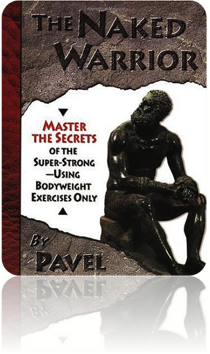The Great Equalizers
Gray Cook, RKC, author of Movement
October 6, 2010 10:01 AM
In the book
Movement, my co-authors and I discuss self-limiting exercises, including a chart accompanied with a list and more in-depth explanations of the concept. We discuss the notion in the context of exercises that naturally impose simultaneous yet

paradoxical physical demands like strength and balance, or power and control, performance outcomes. Simply stated, these activities force superior mental and physical engagement. They require basic body knowledge—movement competency—alongside appropriate physical capacity and technical competency.
Natural limitations have always kept us in touch with our weakest links. Our weakest links, although annoying and inconvenient, are pivot points of our performance and must be addressed. In
Kettlebells From the Ground Up (two DVD set and manual), Dr. Mark Cheng, Brett Jones and I introduced a new twist on an ancient exercise. Our agenda was to pay respect to the very nature of self-limiting exercise.
While some were trying to figure out how to make the Turkish Get-Up (TGU) harder, we were saying it's hard enough if you just slow down and do it correctly.
We gave this wonderful display of movement and strength a great complement by labeling it two ways. We consider the TGU a basic screen and fundamental exercise. It's a screen because its seven steps can expose nicely packaged movement problems that can be viewed up close in a particular pattern of movement. This is much better than trying to pick out imperfection during the execution of an entire seven-step TGU. It can also expose fundamental asymmetry with movement, which research is now showing increase risk of injury. You will find many references to this in
Movement.
As a fundamental exercise, the TGU can be use as a pre-workout systems check, a neuromuscular warm-up, a physiological warm-up, dynamic stability training, symmetry training and a functional cool-down. The TGU can also be used on a recovery day in place of a light workout to smooth out the kinks.
The TGU challenges three levels of competency or capacity and it will usually expose them in the order they need to be corrected. Let's consider these three points as equal contributions of a complete physical perspective or the three equal slices that make up the complete circle.
- Minimal movement competency—fundamental mobility and stability
- Minimal physical capacity—strength, endurance, coordination
- Technical competency—education and execution of a movement skill
Here is how a self-limiting activity works.
If a particular step of the TGU catches you or presents you with difficulty first, consider this a mobility and stability problem. Unless completely de-conditioned, failure is rarely a physical capacity problem. Difficulty on the first five repetitions is usually imposed by poor movement competency. If movements are clean and free from error initially but an obvious erosion of quality is noted across a few exercise packages, consider this a physical capacity problem causing a high degree of fatigue.
Technical competency for the TGU should never be an issue initially, since minimal movement competency and minimal physical capacity should be established at each step of the TGU before the performance of the complete activity. If technical precision with the TGU is a problem but all the steps are free from movement error or physical capacity limitation, the only logical problem is performing the technical skill of the TGU. Proper coaching and effective linking of the individual steps within the TGU can address this.
By following this platform, you will always know the level of the problem. If you just jump into the TGU and see a problem, you are left to guess where the issue might be. The problem is your chances of landing on the right slice of pie are 33.3%—worse than a coin toss. So take time and use the steps. They will answer most, if not all, the questions that coaching and training create.
The TGU example serves as a working model of the principles taught at
CK-FMS and in our new book
Movement, Functional Movement Systems. We teach you how to establish a safe movement base to support the physical and technical training you already provide. The TGU is not the only exercise that imposes a natural self-limiting concept—look over our list of self-limiting exercises in the book.
Self-limiting activates are all around us. Historically, the obstacle course has been a cornerstone of military, fire service and other career choices that require physical production and performance. It imposes self-limiting qualities through its variety of barriers to forward progress. The inherent message in the obstacle course is a subtle suggestion of natural selection. Nature prizes adaptability and punishes specialization. Runners will be challenged by the climbing, and the running might challenge climbers. Those who train endurance may post slow times, while those who train speed my run out of gas. The guy who likes to press weight might not be able to lift his own bulk.
The message is that the biggest obstacle is usually you. You must not waste energy, and if you have mobility and stability problems, you will not be able to move efficiently. When multiple demands are imposed, efficiency is king. This means natural environments change and organisms that maintain some level of fundamental adaptability will thrive across the timeline. Specialization is tempting since it affords sort-term

success in stable environments, but unfortunately environmental stability is never the constant. Even if you can control your environment, you will change with age, so don't try to cheat nature—stay adaptable, a message embodied in Pavel's classic book,
The Naked Warrior. The same year Pavel gave us his great work, I published Athletic Body in Balance, and even though we introduced different methods, we were, and still are, driven by our principles, principles of movement.
Please don't misinterpret our intentions. We both realize that high demand professions require physical development and technical specialization. We simply refuse to let those entrusted to us crack their foundations while they add ornaments to the roof. This implies that although technical skill must fit the task, the physical platform supporting the skill must remain adaptable, fundamentally mobile and stable within basic movement patterns. The correct pursuit of enhanced physical capacity and technical mastery should not reduce fundamental movement pattern quality. If it does something is missing.
Unfortunately, the directive to stay adaptable has become distorted and confused. The obstacle course like the
RKC requires a competent display of many physical attributes. The intention is to own all minimum requirements before you go for a max. Meet your movement minimums by owning the TGU and passing the FMS minimum requirements. Own your physical capacity by demonstrating resistance to fatigue in all your lifts. If you do these two things, your ability to adapt to new demands and learn the technical aspects of new lifts will be natural, the way it was intended.
The human signature of adaptability is unique operational platform—don't lose it!
First move well—then move often!
Gray Cook, RKC, MSPT, OCS, CSCS, is the author of
Movement, Functional Movement Systems. Please visit movementbook.com for expanded thoughts on the new book, Movement. For more information on movement screening, assessments,
certification and registry, go to
functionalmovement.com.
Back